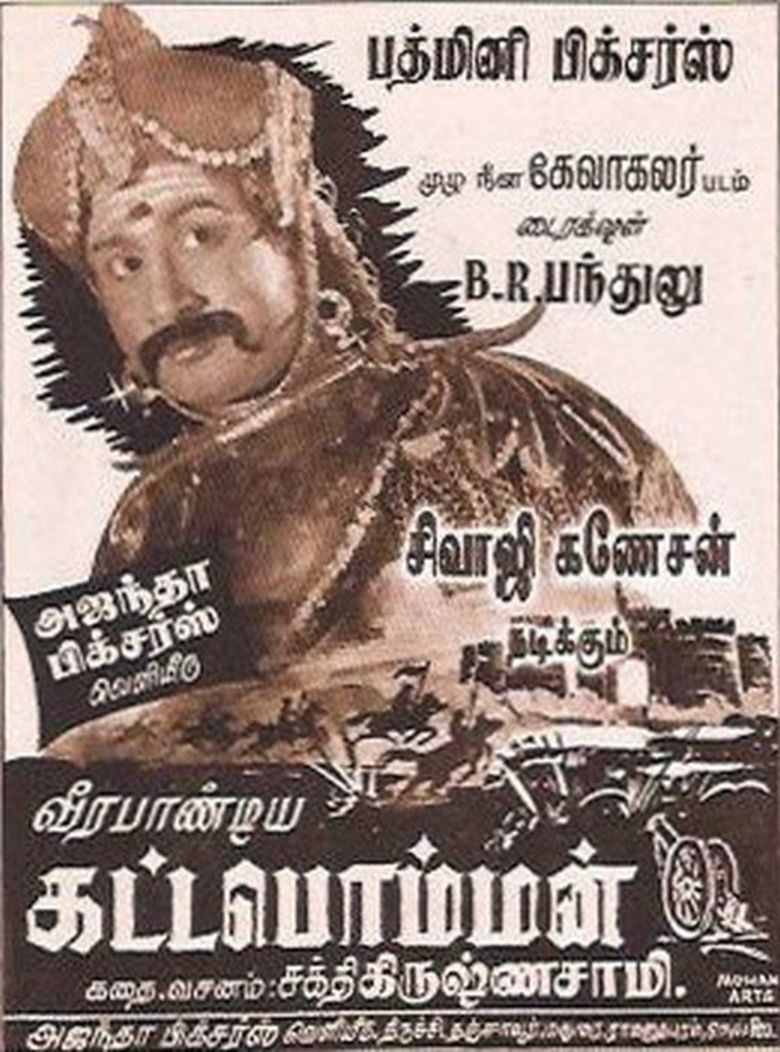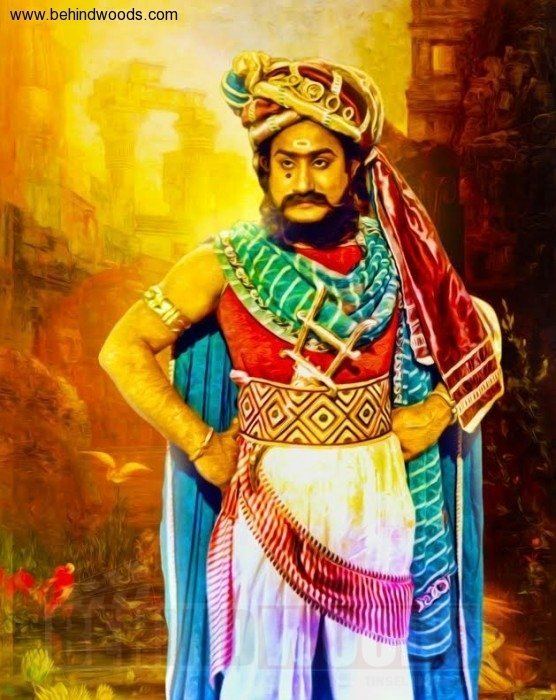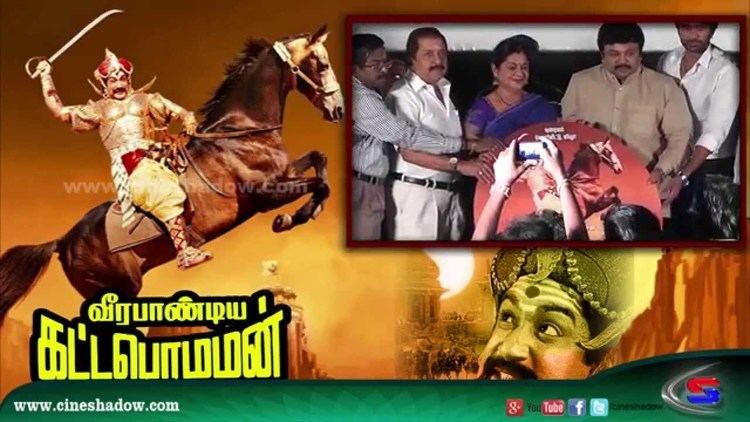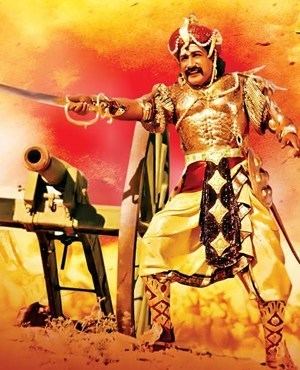Veerapandiya Kattabomman (film)
6.1 /10 9 Votes
Director B. R. Panthulu Country India | 7/10 IMDb Duration | |||||||||||||||||||||||||||||||||
 | ||||||||||||||||||||||||||||||||||
Release date 10 May 1959(London premiere) Based on Kattabomman by Sivaji Nataka Mandram Similar Parasakthi (film) , Karnan (film) , Kappalottiya Thamizhan | ||||||||||||||||||||||||||||||||||
Veerapandiya Kattabomman (English: Kattabomman, the Brave Warrior) is a 1959 Indian Tamil-language biographical war film directed B. R. Panthulu. The film's screenplay was written by Ma. Po. Sivagnanam while its story and dialogue were written by Sakthi T. K. Krishnasamy. The film features Sivaji Ganesan, Gemini Ganesan, Padmini, S. Varalakshmi, and Ragini in the lead roles, with V. K. Ramasamy and Javar Seetharaman in pivotal supporting parts. The film's soundtrack and score were composed by G. Ramanathan.
Contents
- Plot
- Cast
- Origin
- Casting
- Filming
- Music
- Release
- Critical reception
- Accolades
- Historical inaccuracies
- Legacy
- Re releases
- References

Produced and distributed by Panthulu under his banner, Padmini Pictures, Veerapandiya Kattabomman is loosely based on the story of the 18th century South Indian chieftain of the same name, who rose in rebellion against the East India Company. The film was an adaptation of the play Kattabomman, performed by Sivaji Ganesan's troupe. Most of the film was shot in Jaipur. Veerapandiya Kattabomman is notable for being the first Tamil film to be released in Technicolor.

The film's premiere was held in London on 10 May 1959, and had its release in Tamil Nadu six days later. It became a critical and commercial success, earning cult status in Tamil cinema. The film had a theatrical run of 175 days. It was dubbed and released in Telugu as Veerapandiya Kattabrahmanna in 1959, and in Hindi as Amar Shaheed in 1960.

The film was the first in Tamil cinema to receive international awards for Best Film, Best Actor, and Best Music Director at the 1960 Afro-Asian Film Festival in Cairo. It also won the National Film Award for Best Feature Film in Tamil under the "Certificate of Merit" section. Veerapandiya Kattabomman was re-released in 1984, and a digitally restored version was released on 21 August 2015. The film was received successfully on both the occasions.

Plot

Veerapandiya Kattabomman, the king of Panchalankurichi, is a brave fighter and a devotee of his family deity, Murugan of Thiruchendur. On receiving news of a robbery in his territory, Kattabomman and his retinue set out incognito to capture the robbers. When they are captured, they confess that they had been hired by the British to create unrest in Kattabomman's domain. They also tell him that the British had enticed the neighbouring chieftain, Ettappan, to help them in their endeavour to annexe Panchalankurichi.

At Chayalkudi, a village near Panchalankurichi, lives Vellaiyammal, who vows to marry the man who tames her pet bull. She takes her bull to participate in a jallikattu game held at Panchalankurichi under Kattabomman's patronage. All those who attempt to tame the bull fail. At Kattabomman's call, his commander-in-chief, Vellaiyathevan, subdues the bull and wins Vellaiyammal's love. Later, Kattabomman learns of their love and has them marry.
Kattabomman receives a message from W. C. Jackson, the collector of Tirunelveli, who demands a meeting with him at Ramanathapuram to discuss the payment of his tribute. Captain Davison, Kattabomman's British friend, advises him to go and see Jackson. Jackson, finding that Kattabomman has come to see him with his troops, demands to meet him alone. At the meeting, Jackson insults him and orders his arrest. Though surrounded by the British troops, Kattabomman fights and escapes, but his Minister, Thanapathi Sivasubramaniam Pillai, is captured by the British.
Some time later, Pillai is released. He brings news that Jackson has been transferred back to England on Davison's recommendation. At Kattabomman's court, a British messenger sent by Colonel Ooshington, Tirunelveli's new collector, reports that Pillai and his men have looted their granaries and killed their men at Srivaikuntam. Pillai justifies his act, saying that he instructed his men to do it because of the famine conditions prevalent in their kingdom. Ashamed of Pillai's act, Kattabomman accuses him of injustice. Pillai apologises and offers himself as a prisoner to the British, but Kattabomman refuses to hand him over; instead he offers money to the British as compensation for the looted rice. Ooshington does not agree and, with Major Bannerman's and Ettappan's help, incites the neighbouring rulers to attack Kattabomman. Bannerman is placed in charge of the British troops. He and Ettappan plan to attack Panchalankurichi when the people are away attending a festival in Tiruchendur. Kattabomman's spy Sunderalingam, overhears this and informs him; he prepares for battle.
On the day of the battle, Vellaiyammal pleads with Vellaiyathevan not to go because the previous night she had a nightmare, which was full of evil omens. Ignoring her entreaties, Vellaiyathevan sets out, and is killed in the ensuing battle. Vellaiyammal, on learning of his death, kills the man who killed him, avenging her husband's death. She finds Vellaiyathevan's corpse and, overcome by grief, dies on it. Bannerman's troops attack Panchalankurichi with heavy artillery and Kattabomman's army suffers badly. Kattabomman is wounded in the neck, but is saved by his brother, Oomaithurai. Sensing that the fort cannot survive another cannon barrage, Kattabomman and Oomaithurai flee to the adjoining kingdom of Kovilpatti. Pillai, disguising himself as Kattabomman, misleads the British soldiers who are on Kattabomman's trail. From Kovilpatti, Kattabomman and Oomaithurai flee to Pudukkottai. Thondaimaan, the king of Pudukkottai, is ordered by the British to capture Kattabomman and Oomaithurai. Fearing the British, Thondaimaan captures the two and hands them over. While Oomaithurai is jailed, Kattabomman faces a trial by the British and is hanged from a tamarind tree at Kayatharu.
Cast
Lead actors
Supporting actors
Origin
The idea to make a film adaptation on the life of resistance fighter Veerapandiya Kattabomman occurred to many producers in the late 1940s, just after India's independence from the British Raj. In 1947, soon after the British left India, a production company announced its intention to produce Kattabommu (named after the rebel's real name), a "mammoth production" which was to star P. U. Chinnappa; this production did not materialise. Another attempt was initiated in 1953 by producer S. S. Vasan. A promotional poster announcing the project was released in the magazine Ananda Vikatan on 5 November 1953. On 8 November 1953, a notice was issued at Vasan's production company, Gemini Studios, in Ananda Vikatan, stating that anyone who had any useful information regarding Kattabomman and his exploits could send it to the studio's storyboard department.
The concept of Veerapandiya Kattabomman began when Sivaji Ganesan and Sakthi T. K. Krishnasamy were travelling through Kayatharu, where Kattabomman was hanged. While there, Ganesan expressed a desire to do a play based on Kattabomman's life. Krishnasamy immediately agreed, and started to write a script for it. Coincidentally, Ganesan's first exposure to acting was when he saw a street play on Kattabomman’s life titled Kambalaththaar Kooththu. Krishnasamy completed writing the script in a month's time. The play was launched in Salem on 29 August 1957. Ganesan had invested close to ₹50,000 for the sets and costumes. On seeing the play, B. R. Panthulu decided to adapt it into a feature film and hired Krishnasamy to write the screenplay. G. Dharmarajan, who was the set designer, was selected to do the same for the film.
The Singapore-based Indian Movie News stated in 1957 that when Ganesan heard of Vasan's attempt to make a film adaptation on Kattabomman, he personally requested that he abandon the project; Vasan assented, and lent Ganesan important research materials on Kattabomman. Film historian Randor Guy contradicted this in his 1997 book Starlight, Starbright: The Early Tamil Cinema by stating that writers like Kothamangalam Subbu and Veppathur Kittoo were employed by Vasan to conduct extensive research on Kattabomman's life, but the only eligible choice to portray Kattabomman was Ganesan, who by then had become popular after Parasakthi (1952). Guy noted that Ganesan was hesitant to take up the role under Vasan's direction as he was earlier rejected by him for the role of a bodyguard in Chandralekha (1948), leading to Vasan dropping the project. But later on, Ganesan acted in Irumbu Thirai (1960), which was produced and directed by Vasan, and Motor Sundaram Pillai (1966), which was produced by him.
Casting
Ganesan originally offered the role of Vellaiyathevan to S. S. Rajendran, who declined it due to his commitment to the film Sivagangai Seemai (1959). He later requested actress Savitri to ask her husband Gemini Ganesan to play the role, which she agreed to do despite being pregnant at that time. Gemini Ganesan was initially reluctant to accept the role, but eventually agreed. Padmini, O. A. K. Thevar, and V. K. Ramasamy were chosen to play Vellaiyammal, Oomaithurai and Ettappan respectively. S. Varalakshmi played Kattabomman's wife, Jakkamma, and also worked as a playback singer.
The role of Lord W. C. Jackson was portrayed by C. R. Parthiban, while M. R. Santhanam played the minister, Thanapathi Sivasubramaniam Pillai. Kattabomman's daughter in the film, Meena, was a fictional character created by Krishnasamy. She was based on Krishnasamy's own daughter, Mynavathi, who died when she was five years old. Krishnasamy initially refused to include the scene involving Meena's death as it reminded him of his daughter, but finally did so reluctantly. The character was played by Baby Kanchana.
Filming
The film was launched at Sivaji Ganesan's house, Annai Illam. Principal photography began in October 1957 with a puja. Most of the film's shooting took place at Jaipur. With help from Janakaraja, the man in charge of the cavalry division, the production unit of Veerapandiya Kattabomman managed to hire junior artistes to portray the cavalry soldiers for shooting the war scenes.
When the film was being shot at Bharani Studios in 1958, Adoor Gopalakrishnan, who witnessed the shooting on a particular afternoon, recalled that after every take, the actors would rush outside because of the intense heat on the set. He also noted, "The speed of the film was so low those days that one needed many, many lights for correct exposure." Veerapandiya Kattabomman is notable for being the first Tamil film to be released in Technicolor. Panthulu adopted American director Cecil B. DeMille's tactic of personally introducing the film on camera. The final length of the film was 18,086 feet (5,513 m).
Music
Veerapandiya Kattabomman's original Soundtrack album was composed by G. Ramanathan, with lyrics by Ku. Ma. Balasubramaniam. It was released under the Saregama label. The album became a breakthrough for P. B. Srinivas, then a struggling playback singer. He was recruited by Ramanathan to sing the track "Inbam Pongum Vennila", which was picturised on Gemini Ganesan and Padmini, with P. Susheela. The song "Pogaathe Pogaathe" is based on the Mukhari raga, "Manam Kanintharul" is based on the Kurinji raga, and "Singara Kanne" is based on the Brindavanasaranga raga. Theatre actor K. B. Chellamuthu was the violinist for the songs. A remix version of "Inbam Pongum Vennila" was done by Hiphop Tamizha for the film, Aambala (2015).
According to S. R. Ashok Kumar of The Hindu, "Manam Kanintharul" and "Singara Kanne", both of which were sung by Varalakshmi, "remained all time favourites". Of the song, "Pogaathe Pogaathe", singer Charulatha Mani said that it was "a meandering, melancholic Mukhari". She also labelled Ratnamala's rendition of the song as "expressive". Film critic Baradwaj Rangan of The Hindu, in his review of the film's 2015 digital re-release, said that Ramanathan's music "is still superb, spanning the range from folksy to light to classical".
Track list
All lyrics written by Ku. Ma. Balasubramaniam.
Release
Veerapandiya Kattabomman's premiere was held in London on 10 May 1959, and it was released in Tamil Nadu on 16 May 1959. The film was a commercial success and achieved cult status in Tamil cinema, becoming a silver jubilee film. The film was dubbed and released in Telugu and Hindi respectively as Veerapandiya Kattabrahmanna in 1959, and Amar Shaheed in 1960.
Critical reception
Veerapandiya Kattabomman received positive reviews upon release. Ananda Vikatan, in its original review dated 24 May 1959, praised the performance of Sivaji Ganesan, and said the film would make any Tamil proud. Baradwaj Rangan praised Ganesan's performance, stating that: "To watch Veerapandiya Kattabomman is to marvel at the shades and nuances an actor can infuse into oratory." Arun Ram and Riju Mehta of India Today stated in 2001, "One doesn't have to be well-versed in Tamil to feel the fire in Veerapandiya Kattabomman."
According to Sri Lankan Canadian journalist D. B. S. Jeyaraj, Veerapandiya Kattabomman was the first Tamil film that had a great impact on him. He felt that the success of the film "at that time was the portrayal of Kattabomman by the doyen of Tamil actors, Sivaji Ganesan. The highlight of that performance was the powerful delivery of fiery dialogue by the film hero Kattabomman played by Sivaji." N Sathiya Moorthy wrote for Rediff.com in 2001, "[Ganesan's] portrayal of Lord Shiva in [Thiruvilaiyadal] and of freedom-fighters Veerapandia Kattabomman and Kappalottia Thamizhan V O Chidambaram have become symbolic of the very characters in the average Tamil mind across the world."
Guy labelled Ganesan's performance as "breathtaking". Janani Karthik of The Times of India wrote, "Watch this [film] for the legendary actor's performance, something that old-timers remember even today." Another reviewer from the same newspaper criticised the digital version, noting that the colour used looked "leached of the frames" and the sound system was "a bit contemporary." The critic, however, felt "the film still retains its dramatic force" despite these technicalities. CV Aravind of The News Minute described Ganesan's performance as "intensely emotional and moving" whilst labelling it "the hallmark" of the film.
Accolades
Sivaji Ganesan's performance as Kattabomman earned him an international award as the Best Actor at the 1960 Afro-Asian Film Festival, held from 29 February to 11 March. The award was presented to him by Gamal Abdel Nasser, then President of Egypt. This made him the first Indian actor to receive an international award. On hearing of Ganesan's return from Cairo after winning the Afro-Asian Film Festival award for the Best Actor category in 1960, fellow actor M. G. Ramachandran, who also served as the president of the South Indian Actors Guild, organised a huge reception in Chennai to welcome him.
In his autobiography, Ganesan recalled that during the Afro-Asian film festival, "I was called on stage and I went up a diminutive, five foot nothing, looking boyish with my build, whereas they had expected me to be a colossus, on seeing [Veerapandiya] Kattabomman, at least seven or eight feet tall! Irrespective of this they gave me a standing ovation for five minutes."
Historical inaccuracies
Veerapandiya Kattabomman has often been criticised because of its historical inaccuracies. Guy stated in 2015 that a Tamil weekly even went to the extent of saying, "[...] a new face called Kattabomman acted brilliantly as Sivaji Ganesan!" Poet Kannadasan said that Kattabomman was not a real freedom fighter, but a Telugu and a robber. He also stated that the Maruthu Pandiyars were the real freedom fighters and wrote a script about them, which was adapted into the film, Sivagangai Seemai. Kannadasan's statement was supported by writer Lena Tamizhvanan, who denounced Kattabomman's glorification.
In Starlight, Starbright: The Early Tamil Cinema, Guy noted that according to East India Company records, Kattabomman was of Telugu ancestry, and that he was a strong and silent man, not of dash and daring as depicted in the film. Guy also noted that Ganesan portrayed Kattabomman as a "larger-than-life-character, haranguing audiences in a high-flown Tamil replete with literary flourishes", as opposed to the real Kattabomman, who was not fluent in Tamil. Encyclopedia of Indian Cinema by Ashish Rajadhyaksha and Paul Willemen states, "A love interest has been added as well", implying that the character of Vellaiyammal was fictional. Film historian S. Krishnaswamy, writing for The Hindu in 2001, noted that the film was "historically far from accurate" and that it was "more like a costume drama or a mythological".
In their 2010 book, Cinemas of South India: Culture, Resistance, Ideology, Sowmya Dechamma C. C. and Elavarthi Sathya Prakash state that Kattabomman's Telugu identity is used in such a way that "while National historiography tries to elevate him, some versions of Tamil history seem to downgrade him". In 2011, S. Theodore Baskaran said, "Tamil films have scant regard for history. Almost always, they confuse between history and folklore," and added, "Kattabomman was not even a king. His arsenal had just about three to four guns." In 2014, Ramu Manivannan, the HOD of politics and public administration at University of Madras, told The Times of India, "The popular images of [historical] characters have been constructed from oral descriptions and accounts. In some cases, the popular image overtakes the historical one as in the case of Sivaji Ganesan's portrayal of Kattabomman on the screen."
Legacy
Veerapandiya Kattabomman was a landmark film in Ganesan's career, so much so that Tamil people identified Kattabomman with him. The film also became a trendsetter in Tamil cinema and a benchmark on dialogue delivery. The film's success encouraged many in Tamil cinema to make films based on freedom fighters and historical figures, notably Kappalottiya Thamizhan (1961) and Bharathi (2000). The film's Jallikattu sequence also attained popularity.
In 1970, eleven years after the film's release, Ganesan established a statue of Kattabomman at Kayatharu, where the rebel was hanged. L. K. Advani, currently one of the senior leaders of the Bharatiya Janata Party, while visiting Sri Lanka in February 2009, said: "I have seen the Tamil movie of [Veerapandiya Kattabomman], acted by [Sivaji] Ganesan, many times. It is fresh in my memory." A special postal cover designed by film historian and actor Mohan V. Raman was released on 16 May 2009 to celebrate the 50th anniversary of the film's release. The cover was jointly released by the Sivaji–Prabhu Charities trust and the Indo-Russian Cultural and Friendship Society. Politician Venkaiah Naidu said in 2016 that he became a fan of Sivaji Ganesan after watching his performance in the film.
A. V. Ashok wrote for The Hindu, "It is no exaggeration to say that Sivaji's heroic outpouring as Veerapandiya Kattabomman is an integral part of the Tamil cultural psyche." Actor Sivakumar stated, "You can’t reproduce movies like Parasakthi, Pasamalar, Devadas, Veerapandiya Kattabomman or Ratha Kanneer [...] By remaking such films, you are lowering yourself, while it enhances the original artists’ image." Suhasini Maniratnam listed Veerapandiya Kattabomman alongside Kappalottiya Thamizhan, Aayirathil Oruvan (1965) and Iruvar (1997), as her favourite period films in Tamil. The Times of India included Veerapandiya Kattabomman in its list of Top 5 Sivaji Ganesan Films on his birthday. An elephant that Ganesan presented to the Punnainallur Mariamman temple in 1960 was named "Vellaiyammal", after the character from the film. It was later donated to the Brihadeeswarar Temple in 1980.
In Outlook's issue dated 20 October 2008, Ganesan's line, "Vari, vatti, kisthi...Yaarai ketkirai vari...Etharkku ketkirai vari. Vaanam polikirathu, bhumi vilaigirathu, unakken katta vendum vari....", (Roughly translated in English as "Tributes, Tax, Loan, Interest. The rains pour from the sky, the land blossoms, why should I offer you money?") which he speaks in a scene with C. R. Parthiban, was ranked at number 8 in the magazine's list of the 13 Cheesiest, Chalkiest Lines in Indian Cinema. In April 2012, Rediff.com included the film in its list The A to Z of Tamil Cinema. In a January 2015 interview with The Times of India, playwright Y. G. Mahendra said, "most character artists today lack variety [...] Show me one actor in India currently who can do a Kattabomman, a VOC, a Vietnam Veedu, a Galatta Kalyanam and a Thiruvilayadal." Actor Rana Daggubati, in an interview with Sangeetha Devi Dundoo of The Hindu, said that Ganesan's performances as Kattabomman and Karna (in the 1964 film Karnan) served as inspirations for his role in Baahubali (2015). The scene between Ganesan and Parthiban was later featured in the 2016 film Jackson Durai, which was titled after Parthiban's character. M. Sasikumar's Balle Vellaiyathevaa, released in the same year, was named after a dialogue uttered by Ganesan's character.
Re-releases
Veerapandiya Kattabomman was re-released in 1984 during Ramachandran's tenure as Chief Minister of Tamil Nadu. The film was granted tax exemption by the state government and was commercially successful at that time as well, running for 30 weeks in theatres. In 2012, following the commercial success of the digital re-release of Karnan, Raj Television Network announced that they would re-release Veerapandiya Kattabomman in 3D in early 2013, but that did not materialise.
In March 2015, Raj Television Network announced that they would release a digital 5.1 surround sound version of the film in collaboration with Sai Ganesh Films, on an unspecified date in April, though it was eventually released on 21 August 2015. Murali B. V., coordinator of Sai Ganesh Films, which helped in the restoration and digitisation of the film's original prints, told The New Indian Express that it took nine months to clean the film prints and completely restore them for digitisation from the original 35 mm film prints with mono sound. The digitised version collected ₹553,000 in its opening weekend from 39 shows in Chennai, and emerged a commercial success.
References
Veerapandiya Kattabomman (film) WikipediaVeerapandiya Kattabomman (film) IMDb Veerapandiya Kattabomman (film) themoviedb.org
